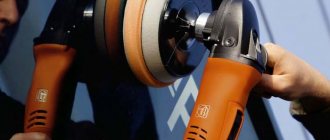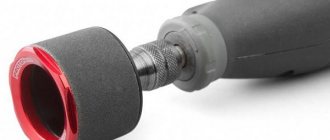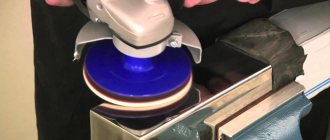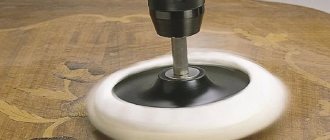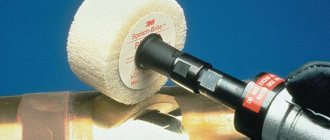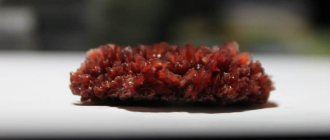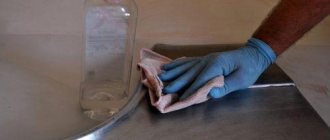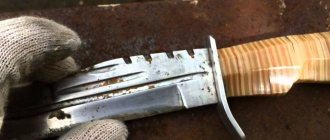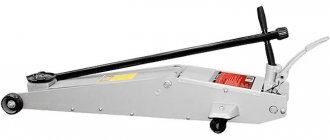The appearance of a car often worries owners no less than its technical condition, which is why many people polish the body regularly. This not only allows you to give the car a presentable look, but also protects the paint layer from premature destruction. Properly selected drill attachments for car polishing will allow you to complete the work as accurately as possible, ultimately obtaining an excellent result.
Assortment of attachments
The most common products for processing automobile bodies are: sponge-like, abrasive with varying degrees of grain, felt, having a soft surface. They are conventionally classified according to the type of production into two types:
- petal (has high productivity and high price);
- surface grinding (made like a rubber disc with an additional coating for processing).
The material for these items is dense foam rubber or felt, which has different diameters. However, kits are sold that consist of several elements that have different purposes and manufacturing complexity.
Making your own nozzles
If there is no suitable option on sale, then for a disk with a high level of rigidity you can make a soft layer of great thickness and place it between Velcro and a plastic base. Using a utility knife, you need to cut off the Velcro where the soft layer will be glued. For the soft layer, a bath sponge is mainly used. It must be remembered that individual elements can shift, breaking the overall symmetry.
You can also use a felt disc, which is used in a polishing machine and machine. First, you should make a pin with a suitable diametrical size and apply a thread on one side. On this side you need to secure the disk, which is surrounded on both sides by a wide nut and a limit washer. This device is not difficult to manufacture and can be used to process various surfaces.
Advantages and disadvantages of sanding attachments
Despite the abundance of solutions, such devices are still auxiliary and are not suitable for solving specific problems. One of the main drawbacks is the weight of the drill. It is difficult to hold a heavy instrument with outstretched arms or above your head. Because of this, the quality of surface treatment and the duration of the procedure suffer.
But where high precision is not required, such as stripping materials or peeling walls, this point is not critical. In a word, a grinding attachment for a drill is a household device that does not pretend to be of a professional level.
A clear advantage of a tandem of a drill and an attachment is its low cost and accessibility. By spending a few hundred rubles, you can get a return that is more than adequate for your household needs. Whereas buying professional equipment will cost a pretty penny. And it is not a fact that the tool will be needed after the necessary work has been carried out.
Application nuances
A drill attachment for car polishing can be purchased at any store that sells car products. However, you should choose these devices carefully.
Body elements of new cars are made using modern technologies. An anti-corrosion compound and paint are applied to the metal, which are wear-resistant. They will last approximately 15 years. However, this coating is better preserved if it is properly cared for. The polishing device restores the original shine and removes defects from the surface. Together with a special product, such a product will cost less than services provided in a workshop.
Body polishing
The polishing process can correct only some defects. If there is corrosion, chips or damage on the body through which the steel frame is visible, then a major repair will be required.
Before starting the polishing process, you should carefully inspect the vehicle to ensure that any imperfections can be eliminated.
Treatment of the body with a special device will give a positive result if:
- slight difference in shades that resulted after partial coloring;
- the presence of roughness, scratches and cloudy stains;
- faded layer of paint;
- the appearance of graininess and streaks of enamel.
You need to know that you can’t overuse polishing, because when you do it, the paint layer becomes smaller by 5 micrometers. From the date of manufacture of the vehicle, no more than 20 polishing procedures can be performed. At this time, you need to use a thickness gauge, especially if the car is used.
Where to buy car polishing attachments?
You can purchase a set of attachments for polishing in hard-to-reach places on our website. We offer high quality, attractive prices, fast delivery and an individual approach to each customer. A car polishing attachment can be your assistant in bringing your vehicle into proper shape.
If you need a body polishing attachment and other products, please contact us.
Have questions? Contact our manager by phone! We will be happy to advise you and help you make a choice.
Using a polishing wheel
By using a polishing wheel on a drill, you can update the appearance of your car. This procedure is most effective if you need to smooth out small chips or remove tarnishing of the surface.
The work is carried out in 2 stages:
- removing paint from the body surface;
- applying polishing compound.
Protective treatment is also carried out to reduce the negative effects of various types of precipitation and ultraviolet radiation. It is mainly done when preparing a car for sale. A protective layer (it contains wax or silicone) is distributed over the surface of the body to form a film that is invisible to the eye, repels moisture, and makes the body shiny. You can polish a used car with a soft pad if there is no paint damage. It can also be used with careful treatment with a protective agent.
Polishing glass headlights
Today, glass headlights are extremely rare, because plastic is much more reliable, durable and cheaper. Almost all manufacturers give preference to the lightness and cheapness of plastic. Glass optics are an option for new cars or indicate the presence of an old car.
Polishing glass car headlights
The procedure for polishing plastic and glass is not much different, but there are several features:
- Before polishing, the glass should be restored using special polymer substances. Polymers are colorless, they are completely invisible and maintain the correct dispersion of the light beam. If you ignore this step, there is a high risk of destruction of the grinder wheel, personal injury and increasing the size of the crack. A UV lamp is used to dry the polymer;
- the glass surface should be regularly watered to reduce the temperature and eliminate glass particles;
- a special composition or toothpaste can be used as a polish. Car enthusiasts often prefer toothpaste due to the low cost of the composition. It is applied to the glass and rubbed with felt cloth. After treatment is completed, the remaining product is washed off. Re-processing is performed upon request.
Materials for car body processing
To carry out the car processing procedure, the following materials are needed:
- foam;
- sandpaper;
- grinding compound;
- bike;
- polish.
The product that will be used to treat the body surface must be selected carefully. A paste containing abrasive particles is needed to remove the top layer of varnish. It must be selected depending on the type of cracks and chips present on the body. A product with a large number of particles is necessary if the defects are very noticeable. Nowadays there is a large assortment of drugs on sale that add brightness to color.
Read also: Relative viscosity is measured using a capillary viscometer
The protective coating of a new car may develop cloudy streaks. In such a situation, a restorative paste containing a grinding additive will be sufficient.
A variety of tools allow you to solve any problem. For vertical surfaces it is convenient to use a thick paste. It can be used to process any part of the machine. It is often added to components that increase the brightness of the color.
A polish with a liquid constitution is suitable for a horizontal surface, for example, a roof or hood. The main advantage of this product is that it cannot damage the enamel.
Convenient to use aerosols. They are economical and effective. However, the can does not contain very much product.
No matter how carefully the driver drives his car, the paintwork becomes covered with chips, scratches and “worn out” spots over time. These damages occur due to careless driving, driving on unequipped roads, or due to temperature changes. To update paintwork, it is enough to prepare an angle grinder and select suitable polishing wheels for polishing a car.
How to make car headlights more transparent
If the plastic has darkened in places, become cloudy and dull, it is first recommended to conduct a full inspection of the headlight. Determining the degree of contamination and the level of damage will help determine the nature and scope of restoration work.
Do-it-yourself headlight polishing
If the plastic is not damaged, but the car is very dirty, washing with a special substance for washing glass will be enough. For minor damage, use toothpaste, preferably with a whitening effect, or “GOI No. 1”. They are applied after preliminary washing. The paste is a slightly abrasive substance with the ability to level the surface.
If more serious problems with optics are detected - relatively deep scratches, chips, many small cracks, etc. - the driver has two ways to solve the problem:
- take the car to a service center, where the procedure will be performed by specialists. Advantage - high quality of work, sometimes a guarantee;
- Polish the plastic coating yourself. There are many effective ways to polish headlights. Each of them will help you save money.
Before carrying out polishing yourself, you should prepare for the work:
- identify the presence and complexity of defects;
- choose the right polish for optics;
- determine the order of work.
Circle materials
Minor abrasions and small scratches are removed with fur discs. For hard-to-reach places, wool products are used. Polishing wheels are selected depending on the abrasiveness of the paste, the location of work, and the diameter of the area being treated.
Felt
Felt discs are more in demand in body polishing. There are several types of products, depending on the degree of wooliness of the coating. Thick-haired drill polishing attachments are faster at removing serious damage to painted surfaces. Fine-haired discs are used less often.
Felt polishing attachments are available with a diameter of 70-250 mm. The width of the polishing layer does not change.
Felt
Felt wheels are used at the main processing stage, for soft grinding, before finishing polishing. Features of felt products:
used to treat different types of damage; effective for polishing metal; suitable for processing headlights, glass and plastic elements. The felt polishing wheel should be periodically moistened with water. This way it polishes several times more efficiently. Almost any paste can be used with felt discs.
Fur
When the polishing machine is running at maximum speed, the fur fiber begins to act like a thin blade. Thanks to the use of such a polishing wheel for angle grinders, scratches on the paintwork are crushed into a fine scratch, which is then easily removed with a softer polishing wheel. Compared to a foam product, the latter only rolls the edges of the scratch, so it is not effective in removing medium and deep damage.
To work with a fur polishing wheel, use medium and coarse abrasive paste. Another advantage of a fur polishing pad is that it heats up the paint surface significantly less, which reduces the risk of burning through the finishing layer.
Rules for working with fur attachments made from natural materials:
- The disc is attached directly to the substrate. A 1 cm layer of foam rubber should be used when working on protrusions and ribs.
- After use, the 3M polishing wheel should be washed with warm soapy water. The fur fibers are dried by idling the sander at maximum speed.
- Effective use of the fur disk can be achieved after “trampling” it.
- To do this, you need to go through several cycles - work, washing, drying.
- Branded polishing attachments are made from natural sheepskin. Such products do not shrink even after several dozen washes.
Other types
When abrasively processing the body with a grinder, wool wheels are often used. They are able to quickly remove oxidation marks on paint and scratches. When using wool pads to polish a car, the overall work time is reduced when compared with foam products. In this case, the paint coating heats up significantly less.
The main disadvantage of wool baits is that they leave circular marks on them. When working with such discs, you will need more abrasive paste. However, not all wool products are designed for harsh abrasive action.
Vulcanite polishing attachments can add shine to metal. They are also called rubber. Such products are made from rubber. The material is vulcanized and then abrasive is added to it. Hundredths of a millimeter of the metal surface are removed with a vulcanite product.
For the roughest processing, abrasive discs are used. The abrasives used are titanium chromium, silicon carbide, and electrocorundum. Most often, 3M straight profile polishing discs are used. All characteristics are indicated in their decoding:
- scope of application;
- diameter;
- profile type;
- grain;
- degree of softness;
- thickness.
The most common are 3M polishing pads. Products from this manufacturer last for several years.
How to use drill attachments correctly
Before using a polishing attachment on a drill, you must select it correctly for the appropriate work. To polish a car, felt plate-type nozzles are used, and to remove rust or paintwork, you will need to use cup and disc devices with metal brushes. If you need to polish a wooden workpiece, then use devices with abrasive coating of fine roughness.
When grinding surfaces, it is important to take into account such a parameter as maintaining the angle of position of the power tool with the nozzle in relation to the materials being processed. If you hold the tool incorrectly, instead of removing scratches, new ones will appear. Before you start processing, you need to practice on different surfaces, and only then take on serious workpieces.
Work can be performed in two ways:
- Hold the drill with the polishing attachment in your hands. This method is the most popular, but it requires experience from the employee. In addition to damaging the workpiece, holding the power tool incorrectly can cause serious injury. If, for example, you lean the cup attachment too much against the surface being processed, it can jam, tearing the tool out of your hands. You must hold the drill or screwdriver firmly and with both hands. Select the required distance and maintain it throughout the entire processing process
- The drill is fixed motionless. This method is convenient when you need to polish the surfaces of small parts. This method is not only considered safe, but also reliable and does not require special experience.
This is interesting!
For polishing, you can use not only a drill, but also a screwdriver.
In this case, you need to take into account the power of this tool, as well as the number of revolutions. If the screwdriver is low-powered, then under heavy loads it may burn out. It is irrational to carry out grinding or polishing with a screwdriver with attachments at low speeds of less than 500 rpm. When performing polishing work with your own hands using a drill with an attachment, you must take into account the fact that the procedure is based on friction, so not only the working part of the devices heats up, but also the motor of the power tool. To successfully complete the work process, you need to take pauses and breaks, especially when using a household electric drill.
It is not so important which attachment is used on the tool, the main thing is to follow safety precautions, so work should be performed with gloves, safety glasses and a respirator. Sanding and scraping a surface creates a lot of noise, so it's a good idea to protect your ears with headphones.
It should also be noted that drill attachments are often used for polishing cars, but few people know that the quality of the work also depends on the use of special lubricants to remove scratches from the car body. These lubricants are usually sold in tubes, and their price directly affects the quality of scratch removal. In order not to spoil the paintwork of your car, you must use only felt attachments on drills, which prevent burning of the paint layer and also do not have an impact on the body.
The use of special attachments for a drill allows you to significantly expand the functionality of this popular and indispensable tool. If you think that it is better to use an angle grinder for polishing and grinding, then there is an opposite opinion on this matter. A grinder that does not have a speed regulator is not suitable for polishing, since you can not only damage the surface being treated, but also get seriously injured by tearing out the tool under the influence of inertial forces.
Circle hardness
Manufacturers indicate the degree of hardness of products, indicating it with a certain shade:
- white – high hardness;
- orange – universal-purpose disks;
- black – the softest tips.
In addition to hardness, polishing wheels are characterized by the type of surface - embossed or smooth. Hard polishing wheels remove chips and cracks from paintwork. Medium and high softness nozzles are used to create a glossy surface, as well as for processing headlights and stainless steel elements of a car. Relief products of varying hardness are used for large volumes of work.
The choice of paste also affects the quality of the final result. If the hardness of the wheel and the polish do not match, the material being processed can easily be damaged.
Selection by type of polishing
You can select polishing discs by type of polishing, taking into account the required tasks. Motorists polish the body, headlights, glass, and wooden elements.
Read also: How to sharpen shaving cartridges
For headlights
To polish headlights, ready-made kits from the American brand 3M are usually used. They include nozzles for polishing the P500 car on a paper or synthetic basis with a diameter of 150 mm. They are universal and suitable for woodworking and sanding composite materials. For headlights, fine grain products are used.
When polishing light elements, an abrasive based on foam rubber is used. Thanks to the semi-open grain filling, high cutting properties and less clogging are guaranteed. The soft edges of the disc are better at removing damage from corner areas.
For metal
Each metal polishing wheel is flexible and elastic. Due to these qualities, the nozzle is pressed tightly to the surface. The following products are used for polishing metal:
- sheepskin;
- cotton;
- cloth;
- calico;
- fur;
- sisal
You can choose the right nozzle only by knowing the characteristics of the surface being treated and the required level of roughness.
For stainless steel
Processing stainless steel involves several stages. Initially, P180 grit aluminum oxide wheels are used. It's better to start with a finer grain. If there are no changes on the surface being treated, after 4-5 movements, you should use a coarser nozzle.
After the initial treatment, they begin to reduce the surface roughness. To do this, successively change nozzles with aluminum oxide on Velcro with different grain sizes:
When changing attachments on a grinder for polishing stainless steel, each subsequent movement is made across the previous one.
Final polishing of stainless steel begins with the use of a thick felt pad and hard paste. Use a soft felt circle to remove any roughness remaining after the felt.
For glass
To process the windshield, felt wheels or polishing attachments with a felt surface are used. The discs are equipped with different abrasives. It is convenient to distinguish their fraction by color. Glass products are divided into several types, designated by different colors:
- green – circles for rough processing;
- blue – suitable for medium-depth scratches;
- brown – allows you to remove minor scratches on the windshield after treatment
- blue and green discs;
- white – removes roughness and the smallest scratches.
The diameter of glass polishing devices is selected based on the scale of damage. Small discs are best used for pinpoint chips, large discs for extensive chips.
For step polishing, gradually change the abrasive from larger to smaller. The glass body quickly “melts” during rough processing. It is used to remove deep damage. Then the remaining roughness is gradually eliminated with a fine abrasive.
For wood
To polish wood using a grinder, use the following wheels:
- felt;
- with replaceable sandpaper;
- fabric;
- spongy.
The material is chosen depending on the surface.
Wood species are treated with petal wheels made of sandpaper. To make the wood smooth, use fine-grained nozzles. Medium-grain discs help remove a small layer of wood. Old paint is removed with coarse products.
Flap tips are used as finishing tips because they give a smoother surface.
Causes of wear
There are many reasons why headlights wear out:
- ingress of sand and dust;
- damage from small stones from the road;
- adverse weather conditions: rain, snow, fog;
- fading of plastic under the influence of ultraviolet radiation;
- scratches from bushes and branches;
- destruction from aggressive chemicals;
- other mechanical damage.
Polishing car headlights, before and after
Minor but noticeable scratches appear due to sand and small stones from the road. At high speed, various hard particles and stones fly into the glass, damaging the optics. Dirt and sand get into the formed recesses, causing the material to become dull, yellowing and turbidity appear.
Additionally, chips appear in which blockages accumulate, worsening the quality of lighting.
How to make it yourself
It’s worth figuring out how to make a polishing disc for headlights with your own hands. The basis of the disk is linoleum. Its reverse side adheres well to the drill attachment. Foamed polyurethane is used as a substrate. The polishing layer is represented by sandpaper. First, 2 layers of polyurethane are glued onto a piece of linoleum, and then sandpaper.
As you can see, there are many types of polishing discs for grinders, which motorists use to process bodywork, glass, and wooden elements. During the polishing process it is often necessary to change the grain size of products. You can easily create a simple circle with your own hands from linoleum, polyurethane and sandpaper.
The appearance of a car often worries owners no less than its technical condition, which is why many people polish the body regularly. This not only allows you to give the car a presentable look, but also protects the paint layer from premature destruction. Properly selected drill attachments for car polishing will allow you to complete the work as accurately as possible, ultimately obtaining an excellent result.
Performing internal polishing
The best cleaning effect occurs when polishing not only the outside of the headlight, but also the inner surface, otherwise defects may appear: leaking dirt, a visible difference between the treated part and the cloudy area of the headlight.
Algorithm of actions for grinding:
- Dismantle the headlight. Initially, a thorough inspection of the coating is carried out to confirm or exclude the presence of through holes and chips. If the damage is serious and polishing will not help restore it, it is better to purchase new plastic.
- Cleaning. After removing the headlight, all dirt is removed from it.
- Degreasing the surface. You can use a household detergent, but it is better to choose a specialized degreaser.
- Grinding. The cap is immediately rinsed, then a grinding machine is connected, and then the plastic is processed with it. The nozzles should be changed every 3-5 minutes. The duration of the procedure depends on the degree of damage; it is better to focus on the result - the surface should become perfectly smooth.
- Polishing. Polish is applied to the treated and wetted coating. A rag is used for rubbing.
- Installing the headlight into the seat.
What attachments are suitable for polishing cars?
Typically, the following types of attachments are used to polish a car using a drill:
- Felt nozzles, which are soft circles of cylindrical or flat felt. Such nozzles are used both for cleaning the surface before polishing and for final polishing of the surface.
- Sheepskin cap-shaped attachment, ideal for finishing polishing. Using this attachment gives truly brilliant results.
- Circle attachments consisting of a fabric cord or covered with leather. With the help of such attachments you can clean products before polishing, and they are suitable for both flat and embossed surfaces. Leather circles are softer, so they are suitable for delicate processing of varnish or acrylic products, but attachments made of fabric cord can be used for metal processing.
- Foam rubber nozzles. When purchasing such attachments, you should keep in mind that the smaller the cells on the foam wheel, the softer the polishing effect will be.
Read also: How to get living and dead water
In addition, drill polishing attachments are divided into two categories, depending on the shape:
To process a car body with a drill, you will need an adapter - a device on which an attachment or polishing wheel is attached.
Before you start polishing, you need to apply a thin layer of a special product to the surface. During operation, the nozzle will distribute the product over the surface, making it shiny.
Polishing plastic headlights
A number of methods have been developed for polishing glass and plastic surfaces. The store's assortment includes a product for chemically cleaning headlights, as well as a plastic material used for polishing. A chemical cleaner is easier to use and quite effective. In relation to other materials, high recovery efficiency can be noted.
Before polishing plastic headlights, you should assess the level of damage. If there are severe deformations, you will have to use coarse sandpaper. Plastic or glass polish is made using various formulas; the best composition can be selected solely by individual consideration of the surface.
Method No. 1: Abrasive paste
Headlight abrasives containing abrasives are sold in every automotive store. Before application, be sure to read the instructions. The procedure itself is very simple and is no different from other methods of grinding head optics:
- The substance is applied to a previously cleaned coating.
- The paste is rubbed with a soft brush.
- The remaining product is removed with gentle movements.
Polishing plastic headlights using abrasive paste
When choosing the best pasta, it is recommended to pay attention to 4 options:
- Menzerna. The German brand helps remove small defects and cloudiness. Recommended for use by beginners who have no experience in polishing parts. There is no silicone in the composition. A rotary or eccentric tool is used for application. The glass is covered with a small layer of paste and waited for it to dry. When the product has hardened, it is removed with a napkin. This completes the cleaning process. The cost of 1 liter is 2100 rubles.
- ZM. It is characterized by fast action. Manufactured in the USA and meets all technical standards. Numerous user reviews indicate the successful elimination of oxidation marks, scratches and marks from the sanding machine. Suitable for processing glass and plastic. The manufacturer recommends using special polishing pads with the Trizact wheel. The price for 1 liter of liquid is 1,700 rubles.
- APP. The paste is made in Poland and does not contain silicone. Intended for treating coatings with serious damage or when it is necessary to create a matte finish. The product is evenly distributed over the surface and thoroughly polished. Cost – 1500 rubles.
- Farecla. A substance with a high-quality composition made in the UK. Promotes the appearance of an attractive shine on plastic and paintwork. The advantage is the elimination of heat when polishing with a grinder, even in the case of lengthy procedures. The paste is suitable for application by hand and with a grinding machine. If the composition gets on another surface, it can be easily removed with a napkin.
Full polishing will take about 1 hour. To maintain a presentable appearance, optics need to be polished at least once every 2 years. After a high-quality procedure, the throughput of plastic headlights improves by 80%.
Polishing paste FARECLA G4
Method #2: Sandpaper
Automotive stores offer customers specialized kits that simplify the procedure. The main tool of the method is sandpaper; it should be used carefully so as not to damage the surface.
The essence of the method:
- Adjacent areas are finished using masking tape. You cannot use regular tape, as it leaves marks on the paintwork and damages the paint.
- Polish is applied to the target area, and a sponge is used to distribute the product.
- When using sandpaper, initially select the option with P600 grit. It is better to wet the paper before each start of work. It is important to polish using smooth movements with even pressure distribution. The product should not come into contact with the paint.
- Next, change the sandpaper to a version with a P1200 marker; during the work it is recommended to use P2000, then P2500. The smallest grit of sandpaper is used for the final layer.
- Remove any remaining sandpaper from the lens surface. Most compounds can be removed with soapy water.
- If the result remains unsatisfactory, it is recommended to repeat the procedure.
Remember that sanding with strong force can cause small scratches. It is important to regulate the amount of pressure and avoid applying too much force. Before work, it is recommended to wet the sandpaper in a solution of a soapy substance.
Polishing headlights with sandpaper
Method number 3: Toothpaste
An unusual and effective way to remove scratches is to use toothpaste. Additionally you will need:
- distilled water;
- masking tape;
- brush;
- degreaser;
- towels
Felt or felt will help improve the result. An alternative is to use a drill with a sanding attachment.
Polishing goes like this:
- All seals and interfering elements are removed from the headlight, which should be protected from abrasive substances.
- Toothpaste is applied to the surface of the headlight and rubbed with a felt rag or brush. The treatment is performed in a circular motion until the damage is completely eliminated.
- When the surface dries, the paste is re-added to it.
- The remaining product is washed off with water.
Using an electric drill you can speed up the process and achieve a better result. The work is performed at maximum speed when putting on a special attachment.
Polishing headlights with toothpaste
Method number 4: Special sets
If you don’t want to select the material yourself: paste, different paper grains, degreaser, etc., you can buy a ready-made polishing kit. Stores have pre-formed kits for use without using a polishing machine. The kit is perfect for car owners without proper polishing experience.
The main advantage of store-bought kits is the ability to restore the glass of head optics without the use of auxiliary tools. The composition always contains a potent chemical that can remove yellowing, plaque and protect against ultraviolet exposure.
The best kits on the market:
- Kent. One of the most effective recovery kits, manufactured in the UK. Helps quickly remove scratches, restore the original appearance and provide subsequent protection. The set includes 3 products for quick and high-quality polishing. The kit is designed to restore 20 headlights. Price position – 12,000 rubles, 600 rubles per lens.
- Turtle Wax. This is a professional kit from England that can be used to repair damage to any headlight material. The special composition improves the efficiency of light transmission recovery. The kit comes with polish, lubricant, abrasive and gloves. Price – 900 rubles.
- ZM. An extremely simple set, its advantage is its low cost and the highest quality. Used for plastic headlights. The set includes polishing and grinding discs with different grits, polishing paste and a mandrel. Cost – 3000 rubles.
ZM for headlight polishing
Method number 5: Using a grinder
To ensure that headlight polishing goes smoothly, you will need:
- fine-grained sandpaper;
- tape with paper to create a protective layer around the headlights;
- sander;
- set with fine and coarse abrasive polishes.
When the materials are ready, it’s time to start preparing:
- if you have jewelry on your hands, remove them so as not to interfere with your work;
- put the tools in working condition and place them close to the car.
Polishing headlights using a grinder:
- Restoration begins with surface preparation. Degreasing is a procedure for treating a surface with a special solvent or shampoo.
- Next, adjacent body elements are glued to protect against damage to the paintwork.
- Sanding the plastic with coarse-grain sandpaper, then with finer grains. One of the processing options: first, coarse-grain paper 600, then 800, 1000, and so on up to 4000. The headlight is processed with each material for about 3-4 minutes. To prevent heating due to friction and accumulation of chips, the sandpaper is wetted in water.
- Polishing using a grinding machine. Polish is applied to the headlight and a foam rubber circle is put on. Processing is carried out until the original appearance is restored.
By cleaning with abrasive paper, scratches of varying depths and chips are eliminated. Additionally, sandpaper creates a matte effect.
Polishing headlights with a grinder
Types of car polishing
There are two ways to polish a car:
- protective (delicate);
- abrasive (restorative).
The protective method of polishing is a kind of prevention that allows you to maintain the paintwork of the body in its original form. For this treatment, a non-abrasive polish (wax, Teflon) is used, which refreshes the color and smoothes out microcracks.
The abrasive method is relevant for eliminating small defects: plaque, small cracks and chips. For such polishing, abrasive agents are used, the use of which is carried out as follows:
- Existing defects or the oxide layer are removed using sandpaper or abrasive polish.
- The final surface treatment is carried out using non-abrasive products and special attachments for a polishing machine or drill.
Experts do not recommend using grinders for polishing cars, since most models of grinders do not have a speed controller, while on a drill this indicator can easily be set in the required range. If you still plan to use an angle grinder, you should not process the bumper, headlights and moldings with this tool to avoid damage to them.
Manual headlight polishing without a machine
The technology for manually polishing headlights without a machine is somewhat different from mechanical polishing.
To carry out the work, you will need sandpaper with a grit of 1500, 2000, 2500 (for deep damage, you can use a coarser one), fine abrasive paste, water, rags or napkins. In this case, it is better to perform the work on a removed optical device.
Having prepared everything, you can start:
- We wash the headlight;
- Wet the surface;
- We do rough sanding using coarse sandpaper. We clean the surface completely and evenly;
- Then we carry out intermediate and final grinding, each time cleaning and wetting the headlight before starting;
- Final grinding is performed with a fine abrasive paste, which is rubbed onto the surface using a rag.
Then we coat the headlight with varnish, and after it dries, we polish it.
Nozzle hardness
Wheels for polishing cars differ from each other not only in the material from which they are made, but also in the degree of hardness. Drill attachments (circles) can be of the following types:
- Solid. They are used to remove scratches and small chips from the car body.
- Soft and medium. Used to give the surface a beautiful glossy shine.
- With a relief surface. They are used if there is a large amount of work to be done to make the car body shine.
Experts recommend using several attachments when working - from harder ones at the initial stage of surface treatment to soft ones, which will be required at the final stage of polishing.
When to deep polish headlights
Full polishing of headlights is carried out in case of severe clouding of the plastic surface, or a strong network of small scratches is found on it.
The whole essence of the work comes down to removing a thin layer of plastic, along with damage, and then bringing the surface to an ideal state.
To restore the transparency of headlights by polishing, you can contact specialists (many service centers provide this type of service). But there is no guarantee that polishing will be carried out according to all the rules.
Therefore, we prepare tools, materials and polish the optics with our own hands.
But in addition to the tools and materials, you will have to study the features and technology of polishing headlights from scratches, because any mistake can lead to destruction or damage to the optics, which cannot be repaired.
Tools and equipment
If you plan to polish a car using a drill, then it is best to use a device that can operate at 1500 rpm. Of course, this figure is not high enough for professional work, but at home it is quite possible to polish the body using a drill.
To perform the work, the following elements are required:
- attachments for a polishing machine or an attachment for a drill, which will allow you to secure the wheels;
- adapter for circles;
- polishing wheel;
- applicator for distributing wax or polish;
- polishing sponge;
- body cleaner;
- scratch remover;
- abrasive paste;
- finishing polish.
When everything you need is prepared, you can start working.
